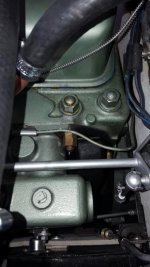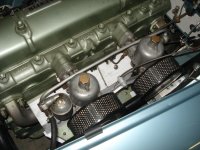First start on a new rebuild of a BJ7 stock motor. Noticed oil bubbling out of the rear most stud. I pulled the head to fix a freeze plug and haven't reinstalled yet. Also pulled the stud. The hole is damp. What should I look for? Do I have a problem?
Also, the Bentley manual calls for bronze washers under the steel washers on the studs outside of the valve covers. My BJ7 didn't have any bronze washers. Should I add some? What's the purpose?
Well, you made me look!
I think it's a matter of interpretation; the first engine section ("A") in Bentley's
The Complete Official Austin-Healey 100-Six and 3000 1956-1968 assumes the earliest version of the Longbridge 6-cylinder. Subsequent chapters deal with the 6-port ("AA") and later 3000 ("AAA") addendums.
Under A.18, Replacing (the cylinder head)
#2 "...Ensure that a bronze washer is fitted below the steel washer on each stud
which passes through the inlet manifold on the left side of the head;"
I've rebuilt many 6-cylinder Healey engines, and certainly at least some of them were previously factory original, and I have never encountered any bronze washers on the head studs. My one (1) opportunity would've been the Longbridge engine that I've posted so many pictures of in the past, but that example had previously been subjected to an Arizona (New Mexico?) high school shop class.
I do not see the need for the sealing washer on a 6-port head (and Jim, your 2-port doesn't have them now either...).
As for the bubbling stud issue, I don't know; it's not near the oil galley, nor the feed-port in the head for the rockershaft (stud's hole depth is about 1", so still >3" of solid cast iron between it and the oil galley). Might've just been a little residual oil left in the threaded bore, and heat expansion forced it out. Only other possibilities are not encouraging (breached gasket, cracked block and/or head) and really remote.
I'd put some thread sealant (like Loctite 518, or similar) and immediately torque it back down.

 Hi Guest!
Hi Guest!

 smilie in place of the real @
smilie in place of the real @
 Pretty Please - add it to our Events forum(s) and add to the calendar! >>
Pretty Please - add it to our Events forum(s) and add to the calendar! >> 



